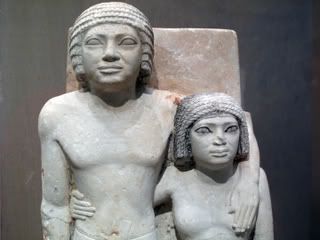
A non-royal couple. Their hair styles can be seen almost exactly like in Yoruba scuptures (wood though -- West Africa did not possess the kind of stone for that kind of work) in certain periods, including today. Though I'm assuming that these are more like wigs or headdresses than actual hair. Again this is early in the Old Kingdom. But cosmetics and their palettes for crushing the minerals that made the cosmetics were already in use previous to the Pharoanic-Dynasty eras.
We only managed to do the Old Kingdom galleries before my back gave out. We'll go back again, soon, for the Middle Kingdom. It's so interesting to do this while re-reading Assmann. We noticed a hieroglyphic that we were convinced was a musical instrument, that might have been a distant forebear of the banjo. We lots of shots of it to ask an Egyptologist friend (specialty New Kingdom naval archeology) what the glyph meant. Imagine our sense of stupid when encountering a glossary of hieroglyphics, that far from having anything to do with music, the glyph meant "the heart and / or windpipe of a mammal." Our friend says she knew exactly which glyph we meant, before reading what the glossary told us. We knew she would.
These digital cameras are excellent tools for archives and museums. We can use them in the galleries that allow non-flash photography. They are successful for recording the explanatory, descriptive notes about the items. Tripods not necessary, generally, with these shake stablized features.
The overwhelming delivery of yesterday though was -- Vaquero in company with a friend who runs the media transfer lab at Columbia, who thinks Vaquero's God -- turned my out-of-print novels into Word dox! I'd lost any digital versions of them when my hard drive melted in New Orleans. One of them was on these huge old floppies, in Word Perfect, the others also on floppies that no computers have drives for now. He fed the pages of the books into the OCR platform scanner, then into pdfs. Then he turned the pdfs into Word dox, and cleaned up the mess that will come with scanning printed pages instead of a 'ribbon' text, particularly with hard returns, itals, periods and commas, missing pages and so on. He brought the books from the dead, which felt so appropriate to our current flow of thoughts around these old dead Egyptians. I was disappointed that the back wouldn't allow me to visit either the Costume Institute galleries or the Armor and Weapons galleries. I spent hours and hours in both of them, researching clothes and swords and early ballistic weapons for these three books. Our own early past as a married couple felt so close to us yesterday, that peculiar closeness we had then, how the creative work each of us did individually had fed the back and forth between us. The past -- as in New Orleans -- is always with us.

No comments:
Post a Comment